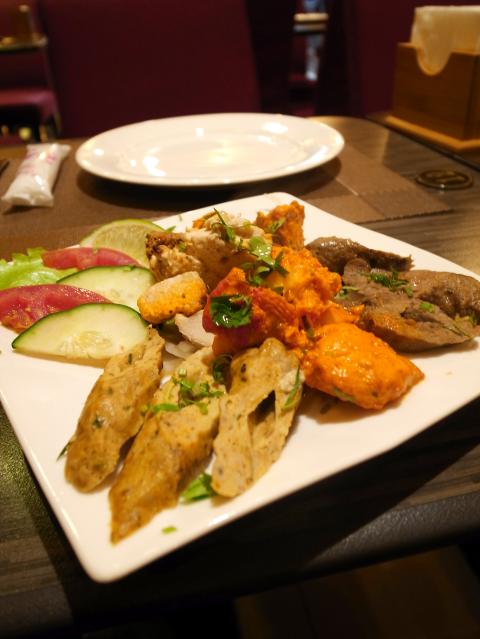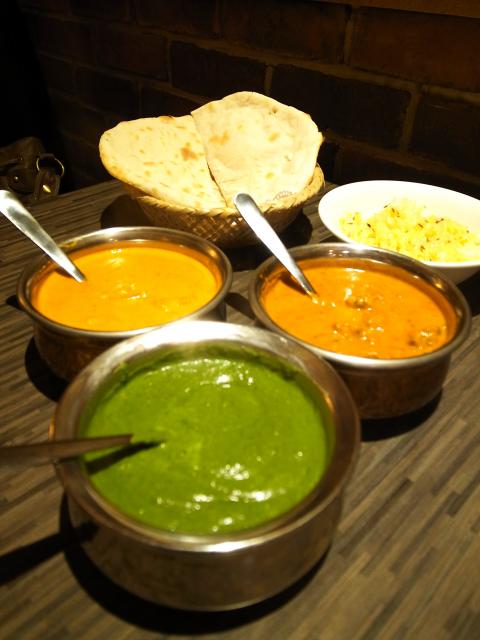Though located within walking distance of Taipei City Hall and the shopping quarter in the glossy Xinyi (信義) District, life on the side of perennially-jammed Keelung Road across from the World Trade Center has been dull, mostly revolving around a few undistinguished food stands, motorcycle repair shops and a convenience store. But things have spiced up a little since Mayur Indian Kitchen launched business over a year ago. And with the arrival of Khana Khazana Indian Restaurant last December, more flavors from the Indian subcontinent are sure to wow local foodies.
Unlike its neighbor Mayur, which is basically a kitchen counter with several tables lined up on the sidewalk, Khana Khazana boasts a spacious dining environment thankfully devoid of gaudy travel photos of South Asian landmarks. Despite its uninspiring entrance that suggests otherwise, the interior, tastefully painted in ocher red and decorated with India-themed paintings, feels relaxed and inviting.
Service is casual and friendly. The smiling young wait staff, though not satisfyingly knowledgeable about the rich south Asian fare, is able to provide suggestions to navigate through the restaurant’s extensive menu that covers north and south Indian cuisine and contains everything from raita salads (NT$120 to NT$180), pakoras (NT$160 to NT$260), rotis (NT$80 and NT$100), paranthas (NT$100 to NT$160) and biryanis (NT$380), to a wide selection of tandoori barbecues (NT$320 to NT$490) as well as keema (NT$320 to NT$360) and paneer dishes (NT$320).

Photo: Ho Yi, Taipei Times
Most of the Indian subcontinent’s better-known curry dishes are also present, ranging from masala, vindaloo, dopiaza and jalfrezi.
Following the recommendations made by our waiter, my friends and I began our feast with tomato soup (NT$90) and multani daal soup, or lentil soup with herbs (NT$90). Deceivingly simple and plain, the dishes wowed with an aromatic explosion of spices and herbs. Appetizer choices are plentiful, and the chana pindi (NT$220), or boiled chickpeas fried with tomatoes, potatoes, chili, ginger and masala, looked healthy and tasted good, but didn’t make a lasting impression.
For Indian barbecues, the tandoori mixed grill (NT$490) has chicken, lamb and fish all on one plate. Served with onions, cucumbers and plenty of lemon slices, the meat was properly charred but was a little bit too dry to my taste.

Photo: Ho Yi, Taipei Times
Moving on to the curry section, which comprises choices of chicken, lamb, fish, shrimp and vegetables. The first item that arrived was the Mughlai chicken (NT$370), which is said to be a famous dish from the Mughlai cuisine served at the imperial family’s dining table in north India. It was creamy, pleasantly mild and there was really nothing not to like about the tender tandoori chicken in cashew nuts sauce.
The chicken tikka jalfrezi (NT$370), another north Indian dish, features boneless tandoori chicken first roasted, then fried with onions and red and green peppers in capsicum curry sauce. It was good and mildly spicy, but all curry dishes can be made more pungent based on customer request.
South Indian in character, lamb tikka masala (NT$360) is made up of tandoori lamb tossed in coconut sauce and makes another smooth and creamy curry delicacy.
Among the restaurant’s array of vegetable dishes, we had the sag paneer (NT$260), which is made with homemade paneer, or Indian cottage cheese, cooked with freshly pureed spinach, ginger and spices. The paneer lent the curry a luscious zest and made it my favorite dish of the night.
Other vegetarian options that come highly recommended include aloo gobhi (NT$280), or cauliflower and potatoes cooked with herbs and spices, and mixed vegetable jalfrezi (NT$300).
For an extra NT$60, diners can have naan and a bowl of pilau rice sprinkled with plenty of cumin seeds to go with main courses. Khana Khazana’s rendition of the Indian flatbread is moist and chewy and comes in seven savory or sweet flavors (NT$40 to NT$120).
For dessert, the restaurant offers homemade cashew nuts-flavored kulfi, or Indian ice cream (NT$120 for two scoops), among the usual gulab jamun (deep-fried milk balls served in sugar syrup, NT$120). Lassi (NT$90 to NT$140) is remarkably yummy and comes in five flavors ranging from salted, mango to peach.
I ended my meal with Indian masala tea (NT$80, NT$120 cold), a great drink to have during cold winter days when it is served steaming hot with cinnamon, cloves and ginger.
According to our waiter, the team that manages Khana Khazana Indian Restaurant comes from the beloved Bollywood Indian Restaurant (魔力屋) in Taichung City. Judging from the quality food it serves, the north spin-off may soon become as popular as its counterpart in central Taiwan.

On April 26, The Lancet published a letter from two doctors at Taichung-based China Medical University Hospital (CMUH) warning that “Taiwan’s Health Care System is on the Brink of Collapse.” The authors said that “Years of policy inaction and mismanagement of resources have led to the National Health Insurance system operating under unsustainable conditions.” The pushback was immediate. Errors in the paper were quickly identified and publicized, to discredit the authors (the hospital apologized). CNA reported that CMUH said the letter described Taiwan in 2021 as having 62 nurses per 10,000 people, when the correct number was 78 nurses per 10,000

As we live longer, our risk of cognitive impairment is increasing. How can we delay the onset of symptoms? Do we have to give up every indulgence or can small changes make a difference? We asked neurologists for tips on how to keep our brains healthy for life. TAKE CARE OF YOUR HEALTH “All of the sensible things that apply to bodily health apply to brain health,” says Suzanne O’Sullivan, a consultant in neurology at the National Hospital for Neurology and Neurosurgery in London, and the author of The Age of Diagnosis. “When you’re 20, you can get away with absolute

May 5 to May 11 What started out as friction between Taiwanese students at Taichung First High School and a Japanese head cook escalated dramatically over the first two weeks of May 1927. It began on April 30 when the cook’s wife knew that lotus starch used in that night’s dinner had rat feces in it, but failed to inform staff until the meal was already prepared. The students believed that her silence was intentional, and filed a complaint. The school’s Japanese administrators sided with the cook’s family, dismissing the students as troublemakers and clamping down on their freedoms — with

As Donald Trump’s executive order in March led to the shuttering of Voice of America (VOA) — the global broadcaster whose roots date back to the fight against Nazi propaganda — he quickly attracted support from figures not used to aligning themselves with any US administration. Trump had ordered the US Agency for Global Media, the federal agency that funds VOA and other groups promoting independent journalism overseas, to be “eliminated to the maximum extent consistent with applicable law.” The decision suddenly halted programming in 49 languages to more than 425 million people. In Moscow, Margarita Simonyan, the hardline editor-in-chief of the